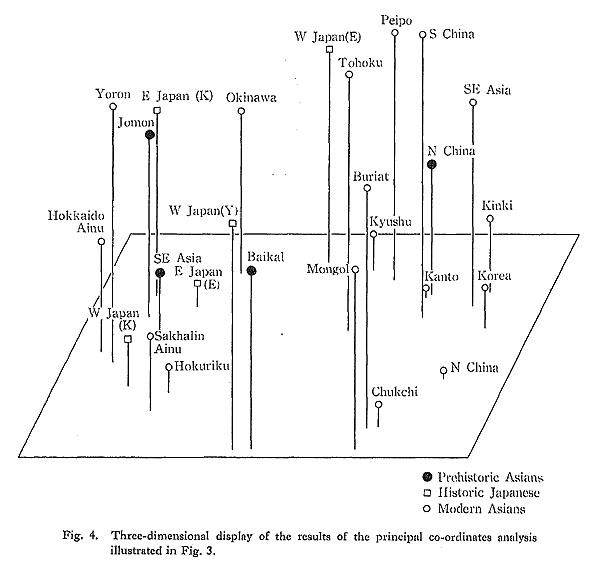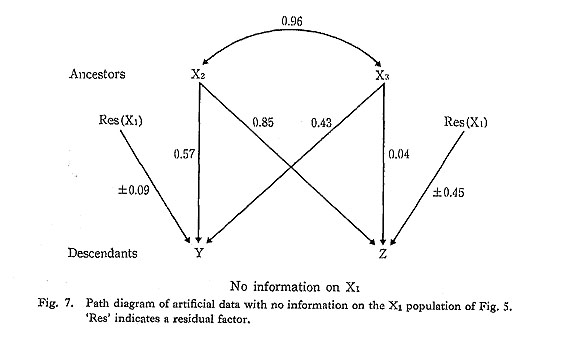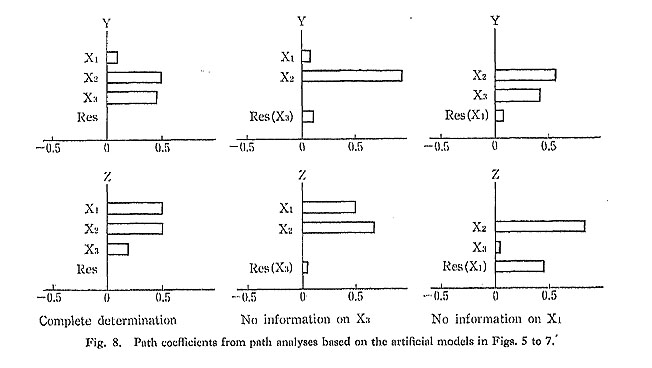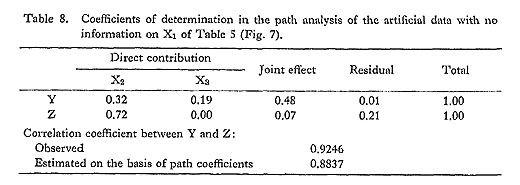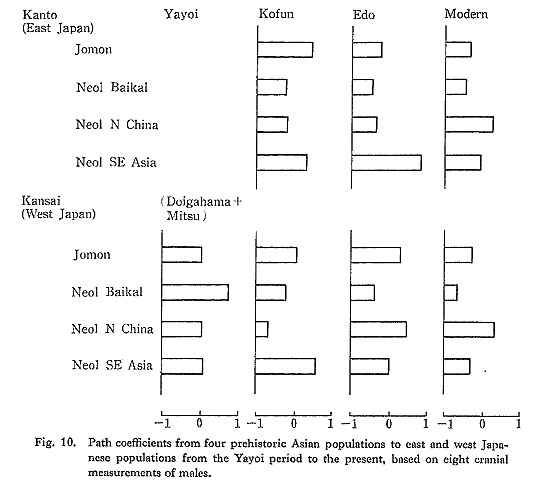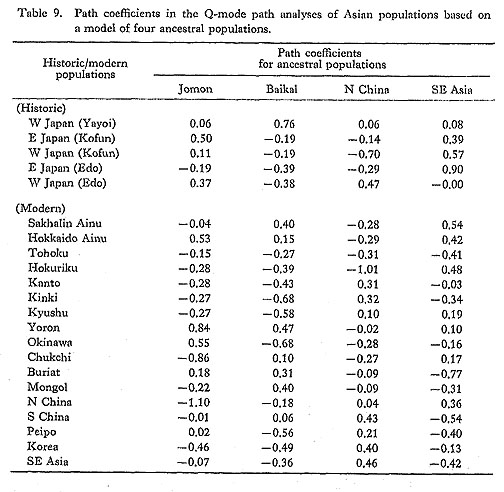PART II
PHYSICAL ANTHROPOLOGY: THE PEOPLE OF JAPAN PAST AND PRESENT
Contributions of Prehistoric Far East Populations to the Population of Modern Japan: A Q-mode Path Analysis Based on Cranial Measurements
|
Yuji Mizoguchi IntroductionAs a means of reconstructing phylogenetic relationships between human populations on the basis of morphological data, anthropologists have used a variety of biological distance measurements or similarity coefficients, None of these distances or coefficients, however, shows anything other than some descriptive differences or similarities between two populations or individuals. Even if we employ such multivariate statistical methods as cluster analysis, canonical analysis, discriminant analysis, principal co-ordinates analysis, or Q-mode factor analysis, all of which deal simultaneously with many populations, the results are substantially the same as those obtained by simply comparing individual distances or similarity coefficients to one another. This is not to say that such methods are of no use: they are very efficient in illustrating clearly the descriptive interrelationships of populations. However, if we want to assess the degree of genetic contribution of possible ancestral populations to a descendant population, these methods are not necessarily useful, This is because, first, there may have been unknown ancestral populations in addition to the supposed ancestral populations, and, second, there may be greater or lesser associations between the ancestral populations themselves. We should therefore examine another method which can detect both the effect of interactions between ancestral populations on their progeny, and the presence of unknown ancestors. If some possible ancestor populations are tentatively linked. to a given descendant population, we may gain some information about the contributions of the ancestral populations and possibly about unknown factors by utilizing the path analysis method (Wright, 1934). In this paper, the practical usefulness of the path analysis method will be examined by applying it to the problem of the origin of the modern Japanese. A historical sketch of anthropological studies on the Japanese will identify the main ideas and issues. Hypotheses on the Origin of the Japanese: A ReviewA great number of anthropological studies on the origin of the Japanese have been carried out (Kiyono, 1949; Hasebe, 1951; Kanaseki, 1976; Yamaguchi, 1977; Hanihara, 1980, 1983; Suzuki, 1981, 1983; Ikeda, 1981, 1982). Suzuki (1981) classified the con- tending hypotheses on the origin of the Japanese into three groups: "substitution theories," "hybridization theories," and "transformation theories." One early version of the "substitution theory" was proposed by P. F. von Siebold, who came to Japan in 1823. It was carried on by his son, H. von Siebold, who wrote "Etwas über die Steinzeit in Japan" in 1878 and "Notes on Japanese Archaeology" in 1879 (Kiyono, 1949). The Siebolds claimed that the Stone Age, or Jomon, inhabitants of Japan were Ainus or ancestors of the Ainus, who later on were gradually driven northwards by an invasion from the south of the ancestors of the modern Japanese. Before the arrival of P. F. von Siebold in Japan in 1823, some Japanese archeologists-T. Hetsutsu, Y. Murakami, M. Kondo, and others-had considered the Ainu to have made and used the stone tools found in the Japanese islands (Kiyono, 1949). Morse (1879) submitted another hypothesis, also a "substitution theory," based on the skeletal remains and pottery excavated by him from the Omori shell mound near Tokyo. He asserted that the people who had made such shell mounds were not Japanese nor Ainu but "pre-Ainu." In other words, neither the modern Japanese nor the Ainu were seen as native to the Japanese Islands. Von Baelz (1883) recognized three principal physical types among the Japanese people: Ainu, fine (Choshu), and coarse (Satsuma) types. He thought that the Ainu had originally lived in the central and northern parts of Japan, and later were driven back further towards the north by invaders. The fine type, which resembled upper class Chinese and Koreans, he thought to have come by way of Korea to southwest Honshu at some unknown period and then spread all over Honshu. And the coarse type he believed to represent a Mongolian race who resembled Malayans, which invaded, also by way of Korea, the west coast of Kyushu and then Honshu after the fine type had arrived. Deniker (1900), von Eickstedt (1934), Taylor (1937), Kroeber (1948), Coon et al. (1950), and others were rather influenced by von Baelz. At the end of the nineteenth century, S. Tsuboi proposed a unique hypothesis that the Kaizuka (shell mound), or Jomon, people, i.e. the aborigines of Japan, were not Ainu but "Koropok-guru." People of this name often appeared in the legends of the Ainu; he thought that they might be associated with modern Eskimos (Suzuki, 1981). In 1890 Koganei argued, based on the skeletons of the Kaizuka people, modern Japanese, and Hokkaido Ainu, that all sites and remains of the Stone Age in Japan belonged to the Ainu (Koganei, 1903; Suzuki, 1981). R. Torii studied Kurile Ainus in 1899 and concluded that the Ainu had formerly made pottery and stone tools, and lived in pit-dwellings; hence, he felt, it was they who had left all sites of the Stone Age found in Japan (Koganei, 1903; Suzuki, 1981). Regarding modern Japanese, however, Koganei considered that they did not belong to a single pure race but were rather a compound race resulting from the admixture of aboriginal Ainus, Malayans who migrated to Japan and brought the Yayoi culture, and basic Mongolians (Suzuki, 1981). The hypothesis of Howells (1966) is almost completely a "substitution theory." He argued, based on discriminant analyses of cranial measurements, that the Jomon people were not primary ancestors of the Japanese, though they might have contributed locally; that the Ainu were doubtless survivors of the Jomon people; and that the essential Japanese people had arrived as immigrants in western Japan during the Yayoi period. Turner (1976) supported this view, stating on the basis of skeletal and dental data that modern Japanese could easily be descendants of migrants from north China; that the Ainu were probably descended directly from the Jomon population; and that the 3100-year-old An-yang Chinese and the even older Jomon people were derived from an earlier proto-Mongoloid gene pool in eastern Asia. Turner (1979) further proposed, based on dental morphology and oral pathologies, that Jomon agriculture could be of great antiquity in the isolated Japanese islands, and that ancestral Jomonese might have carried a cariogenic cultigen such as taro to Japan before the end of the Pleistocene, from tropical Sunda" land by way of the now-submerged east Asian continental shelf. Brace and Nagai (1982), based on tooth crown measurements, arrived at almost the same conclusion as Howells (1966): the recent Ainu would best be regarded as the direct descendants of the Jomon, while the modern Japanese are predominantly derived from the incoming Yayoi but would include a Jomon component. All the hypotheses mentioned above are variants of the so-called "substitution theory." The first "hybridization theory" was proposed in 1875 by Dönitz, who thought that the Japanese were a mixed tribe of Malayan and Mongolian origin, and the Ainu were descended from Mongolian tribes (Koyama, 1943). The hybridization hypothesis of Kiyono and his colleagues (Kiyono, 1938, 1949; Jo, 1938) is very famous in Japan. They excavated a great number of shell mound sites and ancient tombs in west Japan, and obtained the skeletal remains of about 800 individuals (Suzuki, 1981). Based on the measurements of these bones, they calculated Poniatowsky's type differences between prehistoric (Jomon), protohistoric (Kofun), and modern Japanese populations and modern Korean and Sakhalin Ainu populations. They concluded first that the inhabitants of Stone Age Japan were not Ainu nor Japanese but were "proto Japanese" who had originally lived in the Japanese islands. Secondly, they observed that differences between the physical characters of the Kofun Japanese and the proto-Japanese were almost of the same degree as the differences between the Kofun Japanese and the modern Japanese. Finally, it seemed to them that the modern Japanese developed gradually from the proto-Japanese by admixture with races who had originated in the Asian continent or in the South Sea Islands and migrated to Japan by way of Korea; the modern Ainu they saw as having developed gradually from the proto-Japanese by admixture with races originating in the northern regions (Jo, 1938; Kiyono, 1938, 1949). In addition to the above-claimed admixtures, however, Kiyono (1938, 1949) also assumed that changes in environment and condition of life had influenced the physical characters of the proto-Japanese. Kanaseki (1976) supported the "hybridization theory" of Kiyono, especially for the Japanese of west Japan. Kanaseki and his co-workers excavated a large number of skeletal remains of the Yayoi people at Mitsu and Doigahama in western Japan (Ushijima, 1954; Kanaseki et al., 1960). They maintained on the basis of these skeletal samples that a tall people like the Neolithic Koreans migrated from the Asian continent to the westernmost part of Honshu and the northern part of Kyushu during the Final Jomon period, bringing with them a food-producing culture. These immigrants then mixed with the native Jomon people there, producing a population with new physical characteristics, as seen in the Yayoi people of the Doigahama site (Kanaseki et al., 1960). These immigrants did not influence the natives of southern Kyushu at all, but they and others like them apparently came to the western regions of Honshu during the Yayoi and Kofun periods or thereafter, resulting in the taller stature of the modern Kinai Japanese (Kanaseki, 1976). Yamaguchi (1967) pointed out that most theories relating agriculture to the origin of the Japanese were of two basic, alternative kinds. Either 1) agriculturalists who had migrated from elsewhere in Asia rapidly increased their population in Japan and eventually absorbed the native Jomon people; or 2) the native Jomon people took in only the knowledge and technique of agriculture from other people in Asia and changed by themselves through a physical gracilization process to become Yayoi folk. Yamaguchi (1982) later presented basically the same view as Kiyono (1949), particularly noting the importance of a possibly higher population growth rate among the immigrants from the Asian continent than among the contemporary inhabitants of Japan. He also stressed the probability of repeated waves of immigration during the Yayoi period and the subsequent protohistoric Kofun period. He stated that the time lag in the economic transition from food gathering to agriculture seemed to be a main cause for the differentiation between modern Japanese and Ainus in Hokkaido, the latter being considerably more like the Jomon population than the former. Omoto (1978), based on the data of genetic markers in blood, asserted nearly the same hypothesis as Yamaguchi (1982). Ikeda (1982), reviewing many previous works, also appears to have arrived at almost the same opinion as Yamaguchi and Omoto. Furuhata (1962) inferred, based on the distribution of the ABO blood groups, that Pacific island tribes with a high frequency of the 0-factor initially populated the Japanese islands. Subsequently, tribes with a high frequency of the B-factor invaded from the north by way of the Korean peninsula and spread over Japan. Finally, a population with a very high frequency of the A-factor migrated to northern Kyushu and the western parts of the Chugoku and Shikoku districts from some unknown region, then gradually advanced towards the east during the Jomon and Yayoi periods. Based on somatometric data, Kohama (1960) argued that modern Japanese could be classified into two local types, the Tohoku-Uranihon type of partly Ainu origin, and the Kinai type of largely Korean origin. According to him, the Ainus were widely spread over the Japanese islands at first, while later the Kinai type migrated by way of the Korean peninsula and the coast of the Inland Sea to the Kinai district. Kohama considered the modern population of Tohoku-Uranihon type to have been formed by the admixture of the Ainu with the Kinai type. This hypothesis is a compound of the "substitution" and "hybridization" theories. The third type of hypothesis dealing with Japanese origins, the "transformation theory," was advocated by Hasebe (1949, 1951) and has been supported for the most part by Suzuki (1956, 1969, 1981). According to Hasebe (1949), people similar to Upper Cave man from Choukoutien, North China, lived not only in North China but also in South China, Indochina, and the islands of the Indian Ocean at the end of the Pleistocene. Each local group of this widespread population consisted of individuals with various types of faces, as seen in Upper Cave man. At the end of the Pleistocene or the beginning of the Holocene, some of these people came to Kyushu by land, probably from south of the Yangtse River in South China. They then gradually spread over the Japanese islands and evolved through the Yayoi and Kofun phases into modern Japanese, isolated by the sea from the people of surrounding areas. Hasebe considered that the special physical traits which characterized the Jomon people were produced by their peculiar way of life; he perceived no substantial differences between the Jomon and the Kofun people. Furthermore, he argued that the geographical variation in physical characters within the modern Japanese population was primarily a reflection of the variation that originally existed in the ancestral population, and was not caused by admixture with other races (Hasebe, 1949). Suzuki (1956, 1969, 1981; Suzuki and Hanihara, 1982) has collected a great many human skeletal remains, dating from the Pleistocene to the present, in Japan. Based on comparative study of these skeletons, he has asserted that during the Pleistocene, some of the generalized proto-Mongoloid ancestors to Liukiang man and the neolithic people of South China migrated eastwards by way of land-bridges to Taiwan, Okinawa, and the main Japanese islands. Some of them became the ancestors of the Jomon people. Since the disappearance of land-bridges about 10,000 years ago, the Jomon people and their descendants have been isolated from the populations of surrounding areas. Their physical characters have changed from the Jomon period through the Yayoi, Kofun, Kamakura, Muromachi, and Edo periods up to the present due mainly to environmental, especially cultural, factors, not because of admixture with other racial groups (Suzuki, 1981, 1983). Suzuki (1983) claimed that immigrants from the Asian continent contributed significantly to the development of Japanese culture during the Yayoi period and thereafter, but that they had had little genetic effect on the physical characters of the Japanese as a whole. In other words, he concluded that most of the Japanese population had been native to Japan since the Jomon period, and that the geographical variation in physical characters seen among modern Japanese was caused chiefly by specialization within each local region, resulting from mutual isolation and environmental influences. Naito and Matsushita (1981) held the same view for the people of northwestern Kyushu. A hypothesis recently proposed by Hanihara (1983) is a compound of previous hypotheses, but seems basically a "transformation theory." He inferred, based on his dental and cranial data as well as previous work by other authors, that both modern Japanese and Ainus were descendants of the Jomon people. While admixture with immigrants from the Asian continent took place in west Japan during the Yayoi or Kofun period, the fundamental differences between modern Ainu and Japanese were produced through microevolutionary processes occurring after the Jomon period. Data Used in the Q-mode Path AnalysisThe data used here are mean values for eight cranial measurements, published by various authors. They cover four prehistoric or neolithic Asian groups, five protohistoric/historic Japanese groups, and seventeen modern Asian groups. The samples are of males alone. The measurement items, keyed to the system of Martin and Saller (1957), are cranial length (1), cranial breadth (8), basion-bregma height (17), upper facial height (48), orbital breadth (51), orbital height (52), nasal breadth (54), and nasal height (55). In selecting the above measurement items, no special controls were employed for measurement errors or inter-character correlations, though greater measurement error variances have been reported, especially for the orbital breadth and height dimensions (Sakura and Mizoguchi, 1983). For some groups several samples were pooled. Figure 1 shows the geographical distribution of these groups. The labels of the groups and the member samples of each group are as follows: 1. Prehistoric Asians
2. Protohistoric/historic Japanese
3. Modern Asians
The standard deviations necessary for the following analysis represent the weighted means of the standard deviations for twelve Japanese samples (total no. of individuals =478) (Hanihara, 1981). MethodsThe path analysis method was developed by S. Wright as a flexible means of relating the correlation coefficients between variables in a multiple system to the functional relations among the variables (Wright, 1934). Analytical details are described in Wright (1934), Li (1956, 1975), Yasuda (1969), Kempthorne (1969), Mizoguchi (1978), and others. In the present study, this method was applied to a Q-mode correlation matrix, which is a variety of similarity coefficient matrix. Hence, it is referred to as the Q-mode path analysis method. In this study, when comparing the results of the Q-mode path analysis method with those of other multivariate statistical methods, only Q-mode correlation coefficients were used to indicate the relationships between populations. Penrose's (1954) biological distances were calculated for reference. The two multivariate analysis methods adopted for comparison with the Q-mode path analysis are cluster analysis using the group-average method (this is one of the hierarchical methods included in the "combinatorial method" by Lance and Williams) (Okuno et al., 1976), and principal co-ordinates analysis (Gower, 1966). The calculations were performed by the HITAC M-280H/M-200H System (VOS3/ JSS4), of the Computer Centre, University of Tokyo. The programs used are SDQCPC for Penrose's distances and the Q-mode correlation coefficients, CLSTR for cluster analysis, PCAFPP for principal co-ordinates analysis, and PATHAN for path analysis. All were written in FORTRAN by the present author. ResultsBefore describing the outcome of the Q-mode path analysis, the results obtained by ordinary procedures of numerical taxonomy will be presented. Mean values and standardized values for eight cranial measurements represented in the twenty-six pooled samples are listed in Tables 1 and 2, respectively.
Penrose's Shape Distance and the Q-mode Correlation CoefficientIn simple terms, Penrose's shape distance is a variance of the difference between two samples based on standardized deviations of sample means. The Q-mode correlation coefficient is a relative covariance between two samples based on the same standardized deviations. Therefore, both methods are expected to present basically the same results. Since one of the purposes of this paper is to search for the ancestor or ancestors of the modern Japanese population, the present author sought to identify those prehistoric populations which these coefficients showed to be closest morphologically to each modern group. As expected, the two kinds of coefficients showed essentially the same results (Tables 3 and 4):
Among the four prehistoric populations, the Jomon and Neolithic SE Asians resembled each other relatively closely (Q-mode cor. coef.=0.52); the Yayoi people of western Japan were closest to the Neolithic Baikal population; the protohistoric Kofun people of eastern Japan were closest to the Jomon; the Kofun people of western Japan and the early modern Edo people of eastern Japan were closest to the Neolithic SE Asians; and the Edo people of western Japan were closest to the Neolithic N Chinese. Cluster Analysis and Principal Co-ordinates AnalysisThe cluster analysis (Fig. 2) and the principal co-ordinates analysis (Figs. 3 and 4) of Far East populations indicated the following.
These results were basically the same as those obtained by comparing individual distances or similarity coefficients to one another, as expected. The Q-mode Path AnalysisFor estimating the degree of contribution of possible ancestral populations to a descendant population, the path analysis method was applied to the Q-mode correlation matrix. Initially, the results of a path analysis of certain artificial data will be presented to demonstrate the possibilities of the method for finding the contributions of unknown factors or populations to a phylogenetic relationship. When using the Q-mode path analysis method, we assume that the value which repre- sents a certain descendant population is equalled by the sum of the values for each ancestral population. The relationship may be expressed in the form of a linear regression equation. A Q-mode correlation coefficient should be interpreted under the assumption that variables which are standardized in R-mode are normally distributed in Q-mode (Sneath and Sokal, 1973). Using these assumptions, let us consider an artificial example where three ancestral populations (X1, X2, and X3) completely determine two descendant populations (Y and Z) separately. The Q-mode correlation coefficients between these artificial populations are shown in Table 5. The path diagram for the complete determination is illustrated in Fig. 5, where the path coefficients from ancestors to descendants and the Q-mode correlation coefficients between ancestors are represented. In this case, the expected correlation coefficient between populations Y and Z, which was estimated on the basis of the path coefficients obtained, was exactly equal to the observed correlation coefficient (Table 6).
Now, if we had no information about a particular ancestral population, say X3 or X1, could we predict the presence of such an "unknown" population? The relevant path diagrams for this situation are Figs. 6 and 7, respectively. The correlation coefficient between two known ancestral populations is lower in the former (Fig. 6) than in the latter (Fig. 7). As shown in Fig. 8, the path coefficients for the residual variables suggested the presence of the "unknown" ancestral population, though the estimated correlation coefficients between two descendant populations were found to slightly differ from those observed (Tables 7 and 8). Thus, the path analysis method seems useful to detect such unknown factors.
The results of the Q-mode path analyses of Far East populations are shown in Tables 9- 11 and Figs. 9 and 10. From these tables and figures, it is clear that the modern groups most intensively influenced:
Furthermore, the results show that the prehistoric populations most closely associated with the protohistoric or historic populations of the Kanto and Kansai districts changed over time (Table 11 and Fig. 10). The relationships are as follows.
The Yayoi people of west Japan were found to share the characteristics of the Neolithic Baikal population much more than those of the other three prehistoric populations. In short, the Q-mode path analysis results were almost the same as those produced by the cluster and principal co-ordinates analyses. As was expected, however, a fairly large residual factor was suggested (Table 10). The "joint effect" of exogenous variables generally implies positive or negative change in the variance of the relevant endogenous variable due to the correlated occurrence of the contributions of the exogenous variables (Wright, 1934). But the "joint effect" in Q-mode path analysis, as shown in Table 10, may not be so simply interpreted. DiscussionThe three kinds of multivariate analyses presented in this paper, i.e., cluster analysis, principal co-ordinates analysis, and Q-mode path analysis, produced essentially the same results insofar as similarities between Far East populations are concerned. In this point, therefore, the Q-mode path analysis is a practicable method. Further, an analysis of artificial data showed that with this method it might be possible to detect the presence of unknown factors. In the practical analysis of Far East populations, the contribution of the residual factor was very large in some cases (Table 10). This suggests that the formation of the descendant populations cannot totally be explained by the supposed ancestral populations hypothesized here. The high contributions of residual factors may indicate the presence of environmental factors and/or other unknown ancestral populations. A few problems relative to the origin of the Japanese remain to be discussed. In all results of the above three kinds of analyses, a strong similarity was found between the Jomon people and the modern Ainus or Okinawa islanders (Figs. 2, 3, 4, and 9). This is consistent with observations by previous authors such as Koganei (1903), Howells (1966), and Yamaguchi (1982). Furthermore, the resemblance between modern Kinai Japanese and Neolithic Northern Chinese pointed out by Yamaguchi (1981, 1982) was also confirmed. If morphological similarity between two populations of different ages really indicates a phylogenetic affinity between them, the facts shown by the previous authors and by the present analyses as well may suggest that the Ainu are direct descendants of the Jomon people, while most of the modern Japanese are the descendants of migrants from North China, as was stated by Turner (1976), Brace and Nagai (1982), and others. However, using the same logic, it may also be said that the analysis of comparable data on the protohistoric and historic Japanese showed the ancestors of the Japanese to have changed from the Kofun period through the Edo period to the present! According to the results of the Q-mode path analyses in the present study, the contribution of the Neolithic Northern Chinese to the Kanto and Kansai people of the Kofun period and even to the Kanto people of the Edo period is clearly less than that of the Jomon people (Fig. 10). If a large number of immigrants from North China had come to Japan at some time before the Kofun period, or if a small number of immigrants with a higher population growth rate had rapidly increased and driven away or partly absorbed the Jomon people by the Kofun period, the contribution of the Neolithic North Chinese to the Kofun population should be much greater than that of the Jomon. Therefore, it seems unlikely that such a replacement of populations occurred in Japan between the Yayoi and Kofun periods. The Yayoi people from the Doigahama and Mitsu sites resembled Neolithic Baikal folk far more than they did the Jomon people (Fig. 10), as pointed out by Hanihara (1983). This suggests that these limited Yayoi samples represent immigrants from North Asia. However, these Yayoi people could not be the major direct ancestors of modern Japanese because the contribution of the Neolithic Baikal population to the succeeding Kofun people is far smaller than their contribution to the Yayoi people (Fig. 10). The Q-mode path analyses further suggest that from the Kofun period to the present, the Japanese have more or less retained a certain level of resemblance to all prehistoric Far East populations (Fig. 10). But the contribution of the Jomon, Neolithic Southeast Asian, and Neolithic Baikal populations to the population of Japan seems to have gradually decreased, while that of the Neolithic North Chinese seems to have increased after the Kofun period. In simple terms, it seems that immigrants from North China arrived in west Japan after the Kofun period, and had made a major contribution to the Kansai gene pool by the Edo period. Between the Edo period and the present, their genetic input became predominant in east Japan as well. Although there is no historical record that the natives of the Kanto district were almost completely replaced by migrants from west Japan after the Edo period, it cannot be denied that gradual migration and hybridization have continued since the Kofun period. If all tins is so, we have arrived at yet another "hybridization theory." However, it is also possible to account for the above facts in terms of the "transformation theory" represented by Suzuki (1981). That is, it could be that the proportion of features specific to hunter-gatherers and farmers among the natives of Japan has changed with time from the Jomon period to the present because the environment, especially the sociocultural environment, has changed from that of a hunting-gathering society to that of an agricultural and urban one. Many or most of the unknown factors which were suggested by the Q-mode path analysis could be such environmental factors. Perhaps, due to these factors, the morphology of the modern Japanese has eventually become similar to that of the Neolithic North Chinese, who were typically farmers (Okazaki, 1984; Goto, 1984). This morphological change started earlier in west Japan than in. east Japan (Fig. 10), probably because of the earlier establishment of intensive agriculture in west Japan. It should also be noted that differences in physical characters between east and west Japan occur not only among the Kofun people (Morisawa, 1976) but also among people of the late Jomon period (Ogata, 1973; Yamaguchi, 1980). This too could reflect sociocultural factors, if rice cultivation was first introduced in western Japan during the late Jomon period. Moreover, the Ainu of the north may have retained many Jomon features because they continued a hunting-gathering way of life until very recently (Yamaguchi, 1982; Hanihara, 1983). The extreme modernization seen in the skeletal morphology of Japanese aristocrats of the Edo period (Suzuki et al., 1967) may be significant evidence indicating that bones change easily in response to their sociocultural and dietary environments. Summary and ConclusionsAs a method for examining similarities between populations, Q-mode path analysis was demonstrated to have about the same power as conventional methods of cluster analysis and principal co-ordinates analysis. But Q-mode path analysis seems superior to cluster analysis or principal co-ordinates analysis in its ability to indicate the possible presence of unknown factors or populations which may have been related to the formation of a popu- lation under consideration. All the multivariate analyses of cranial measurements in the present study showed that there were three major groups among the prehistoric, historic, and modern Far East populations considered. In particular, the Q-mode path analysis suggested that the morphological characters of the inhabitants of Japan have changed continuously from the Jomon hunting gathering period to the present, culminating in the modern Japanese population's resem blance to Neolithic North Chinese farmers. These observations are best accounted for in terms of a "transformation theory" for the origins of the modern Japanese. The observed changes, as well as the unknown factors revealed by the Q-mode path analysis, are probably a function of still-to-be-specified changes in the sociocultural and dietary environment attendant on the spread of intensive agriculture from the continent into Japan. AcknowledgmentsI am grateful to Associate Prof. Takeru Akazawa of the Department of Anthropology and Prehistory, the University Museum, University of Tokyo, for giving me the chance to do this work. To Dr. Bin Yamaguchi of the Department of Anthropology, National Science Museum, Tokyo, I wish to express my grateful thanks for his valuable comments on the manuscript. I also wish to thank Dr. Hajime Sakura of the Department of Anthro- pology, National Science Museum, Tokyo, Prof, Kazuro Hanihara of the Department of Anthropology, Faculty of Science, University of Tokyo, and Prof. C. Melvin Aikens of the Department of Anthropology, University of Oregon, for their helpful advice. Furthermore, I am greatly indebted to Dr. Hiroo Kanai of the Department of Botany, National Science Museum, Tokyo, for drawing the Fig, 1 map, as well as to Associate Prof. Sadao Shimaguchi of the Department of Anatomy, School of Medicine, Kitasato University, for permitting me to use his program ADBMS1 in preparing this paper. Finally, the assistance of Miss Akiko Nakatsuka is gratefully acknowledged. References
|

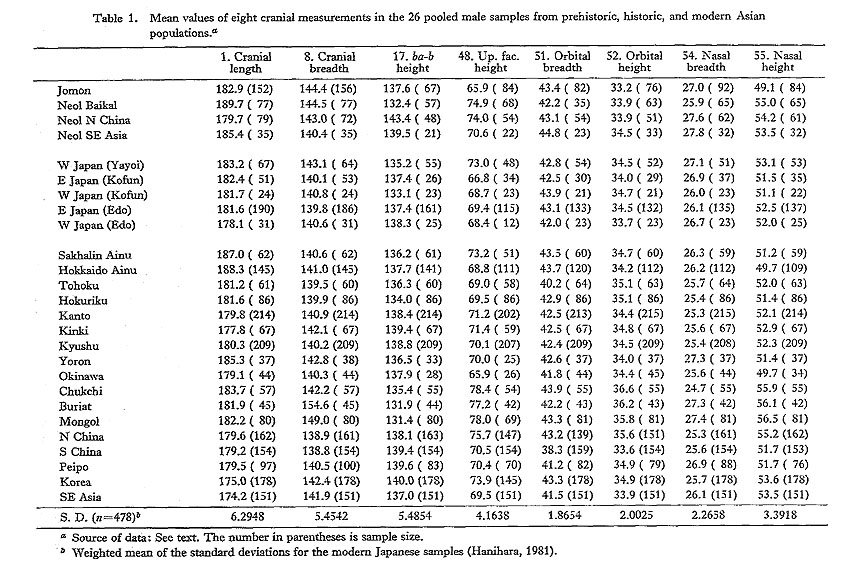

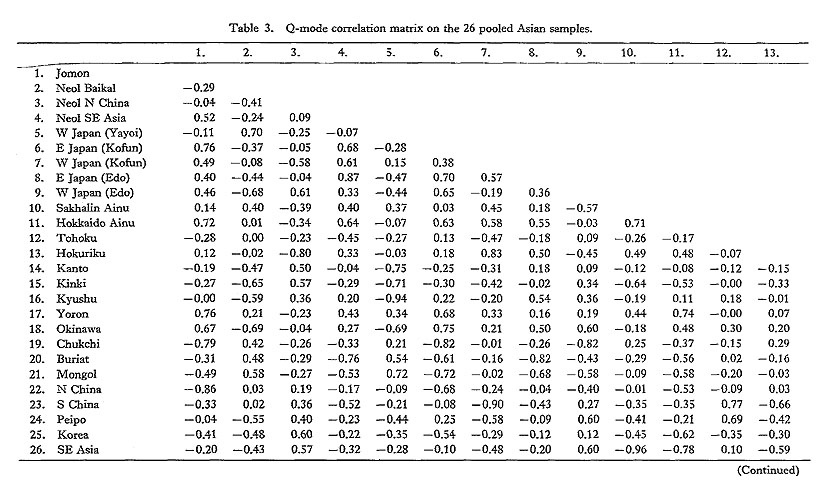
.jpg)



